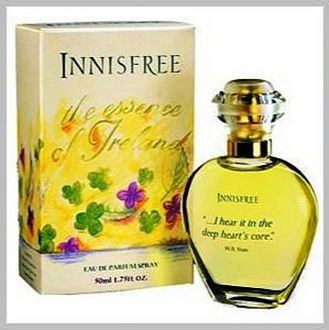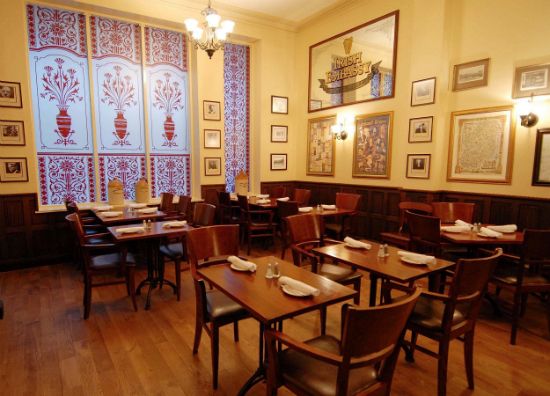
Lake Isle of Innisfree
[Photo by: Pictures of Ireland]
Lake Isle of InnisfreeAs always, with all things beautiful, there is a string of associations.
by William Butler Yeats
I will arise and go now, and go to Innisfree,
And a small cabin build there, of clay and wattles made:
Nine bean-rows will I have there, a hive for the honey-bee,
And live alone in the bee-loud glade.
And I shall have some peace there, for peace comes dropping slow,
Dropping from the veils of the mourning to where the cricket sings;
There midnight's all a glimmer, and noon a purple glow,
And evening full of the linnet's wings.
I will arise and go now, for always night and day
I hear lake water lapping with low sounds by the shore;
While I stand on the roadway, or on the pavements grey,
I hear it in the deep heart's core.
This perfume company has created a scent which it calls Innisfree, after Yeats' poem:
The scent has been developed by us in collaboration with one of the world's leading perfume 'noses' and includes, at its core, lavender oil distilled by us from our field of lavender in County Wicklow - 'the Garden of Ireland'. It is a magical fruit and floral fragrance; the top notes are an accord of Lily of the Valley and fruit notes of Peach, Blackcurrant, and Apricot, in conjunction with Lemon, Bergamot and Lavender. The middle notes are an accord of Jasmine, Rose and Iris constructed on a smooth foundation of the base notes of Sandalwood, Cedarwood and Musk. The overall effect of the fragrance is lightness, freshness and youthful zest which develops into a classically elegant and very rich woody floral perfume of great depth and transparency. There can be no better evocation of all the softness, greenness and richness which compose Ireland. It is a celebration of femininity, nature and Ireland.
We feel that Ireland's beauty, nature and spirit have much to offer the world. Essentially, it is a place of inner peace, which is why so many people travel to experience it. We have tried to capture this in our perfume.

"I hear it in the deep heart's core"
----------------------------------------------------------------------------------------------------------------------------------------------------------
My friendly Irish Pub, Failte, is celebrating St. Patrick's Day all week-end long. I went there yesterday afternoon with my various computer gadgets and a book, and thought it would be a peaceful afternoon of a 1/2 pint of Harp. Instead, I was welcomed with a burst of Irish music.
I asked the Portuguese waiter (Failte's general manager is Portuguese. I had asked him a few weeks ago if I could take photos of the interior, and he gave me his card. "Your name looks Portuguese" I said, which he confirmed) if I could sit in the back, away from the conundrum. But, the music traveled in joyful waves across the various divisions of the pub to where I was sitting. I stopped what I was doing to listen. Irish music is like nothing else. The songs don't sound like English folk songs, or French, or Scottish, which all have some similarity. I'm not sure what it is. I'll have to study it. It seems like a combination of the plaintive and the joyful, a meshing of sadness and happiness.
Below is an online source I found by googling 'analyzing Irish Music.' I don't think it is particularly difficult to understand.
According to Breandan Breathnach in his "Folk Music & Dances of Ireland" there are only two major scales relevant to Irish folk music: the Dmajor scale and the Gmajor scale. Both of these scales fit naturally on the whistle/flute/pipes in D. [Note: Most Irish musicians who play an instrument in a different key than D still tend to think about it (and talk about it) as if it were in D. But the accompanists will have to transpose in such a case. Guitar/bouzouki players will usually resort to using a capo.]I don't want to bore the readers, but musicians (amateur guitar players, or symphonic orchestra players) might be interested to read more here.
By repeatedly applying a process that Breathnach calls "inversion", which simply means detaching the first note from the scale, and appending it (actually, it's octave higher equivalent) to the end of the scale, 7 alternate scales can be derived from this major scale: the "modal" or church music scales. Of these "modal" scales (again according to Breathnach) only 3 are relevant for Irish folk music: the ones based on the 2nd, 5th and 6th note of the major (or Ionian, as it is called in church music) scale, resulting respectively in Dorian, Mixolydian and Aeolian scales.
Scales based on Dmajor:
D major/D Ionian: D E F# G A B C# d
E Dorian: E F# G A B C# d e
A Mixolydian: A B C# d e f# g a
B Natural minor/Aeolian: B C# d e f# g a b
G major/G Ionian: G A B C D E F# g
A Dorian: A B C D E F# g a
D Mixolydian: D E F# g a b c d
E Natural minor/Aeolian: E F# g a b c d e
These 8 scales are the basis for Irish folk/dance music, and will lead us to deriving the appropriate chords for providing backup for this type of music. [Note: occasionally you will come across a tune in Amajor, a key which is not listed here. I've heard a theory (I think it was Arty McGlynn who told me this) that these tunes are not originally Irish, but imported from Scotland. The ideas presented here do not apply to such tunes - these can be dealt with using ordinary "Western art music" chord theory.]
I googled again (please excuse the lack of sophistication) 'Irish music sad and joyful' and I found a musician (I'd never heard about) say this about Irish music:
While in general you are dealing with something sad, sadness occurs but at the same time there’s a kind of equilibrium that comes back in some kind of joy, and in this particular piece, I think I tried to express the idea that life, no matter how brief, is nevertheless majestic.Michael Culhane is talking about his daughter's twins, one who died before birth, while the other was born healthy. So there was loss and sadness, birth and a joy, at this event, which Culhane transposed into his music. This mixture of emotions is of course not solely an Irish trait, but perhaps Irish music captures it best.
Last year, I accidentally walked into a St. Patrick's Day Parade, which I wrote about at Camera Lucida. I compared the modest parade to the aggressive, loud and large Gay Pride parade, and the equally noisy Caribbean Carnival, both of which get government funding to hold their events. The Irish get nothing. Multiculturalism is for select cultures.
Toronto hosts the largest "gay pride" parade in North America, where half naked men and women prance around the streets, rerouting traffic and unsuspecting pedestrians away from the main streets. And the Caribbean Carnival, where there is at least one gun shot, if not murder, every year, brings in thousands of tourists from the Caribbean. The city foots a portion of the bills for both these events. These parades take over the several blocks of streets, and fill the television and newspaper news for days.I also wrote about some brief interactions I had with reveling, polite, Irish-Canadians:
The official St. Patrick's Day parade was last Sunday, and was hardly noticeable. There were no dramatic stories other than a few green-haired jumping leprechauns. It is organized by the The St. Patrick's Parade Society of Toronto, and if you look at their sponsors, not one is a government agency.
Here in Toronto, there was emerald green everywhere today, although the official parade took place last Sunday. It was a rather cloudy day, so the green could be seen from a distance, peppering the streets. What a refreshing gathering of people, who are having a good time, and remembering a good thing. Let's not forget that this is all for St. Patrick, as one girl reminded me when I wished her group "Happy Irish..." "St. Patrick's Day!" we both finished at the same time.The Irish Embassy is actually a pub in downtown Toronto. I pass by it regularly on Yonge Street. I realized this after I walked away from the group and the parade. I've taken photos of the stately building, as well as the pleasant interior. In my long database (some unclassified) of photos, I cannot find what I took. I'll make a quick trip back one day.
I overheard some guy say that the Irish Embassy will be pretty busy tonight.
In the meantime, here is the interior, with portraits of various famous Irish, including the poet Yeats, from the Irish Embassy website.

Yeats' portrait is at the bottom left hand corner:

While in the pub, I checked on the stencils in the back. They're not etched or painted on the glass, but are plastic stick-ons. A little disappointing. But it looks pretty. I wonder if they are copies of an original. The building itself is a renovated landmark:

The first branch of The Bank of North America in Toronto was built in 1845 at the northeast corner of Yonge Street and Wellington. It was designed by architect John Howard.

The redesigned building (it looks like a total demolition, and restructuring) was built in 1875 by Hugh Langley.
This blogger says about the reconstruction:
The structure that replaced the 1845 bank building opened in 1875. The “Royal Arms” from above the doorway of the previous building were relocated to the new structure. However, they have since been removed, likely due to the danger of them falling to the street below. I have been unable to determine their present location. Designed by Henry Langley, the building was described as a structure that reflected the opulence and resources that were appropriate for a successful bank. Others felt that the bank brought to Toronto a sophistication that was reminiscent of those structures found on a Parisian boulevard. Interestingly, it was Henry Langley who popularized in Toronto the Second Empire style with its Mansard roofs. The new bank building was constructed of Ohio sandstone and richly decorated with classical designs. Even today, its Mansard roof appears impressive. Originally, the main entrance to the building was on Wellington Street, but as Yonge Street emerged as the city’s main thoroughfare, the doorway was relocated without any loss of splendour.This seems to be the history of Toronto: restructuring its identity to bring it a sophistication that [is now] reminiscent of those structures found on a [New York Avenue].
I cannot find any information on why the original building from 1845 was replaced in 1875. This was long before the Yonge Street Fire of 1904, which destroyed many heritage buildings along the street. It could be that Torontonians wanted something they perceived as grand, but not ostentatious, which is what the second building looks like.
The current Irish Embassy Pub took over part of the building, and opened on St. Patrick's Day in 2000.

The Irish Charms of a Leprechaun on Yonge Street (Toronto, St. Patrick's Day 2012)
----------------------------------------------------------------------------------------------------------------------------------------------------------
Posted By: Kidist P. Asrat
